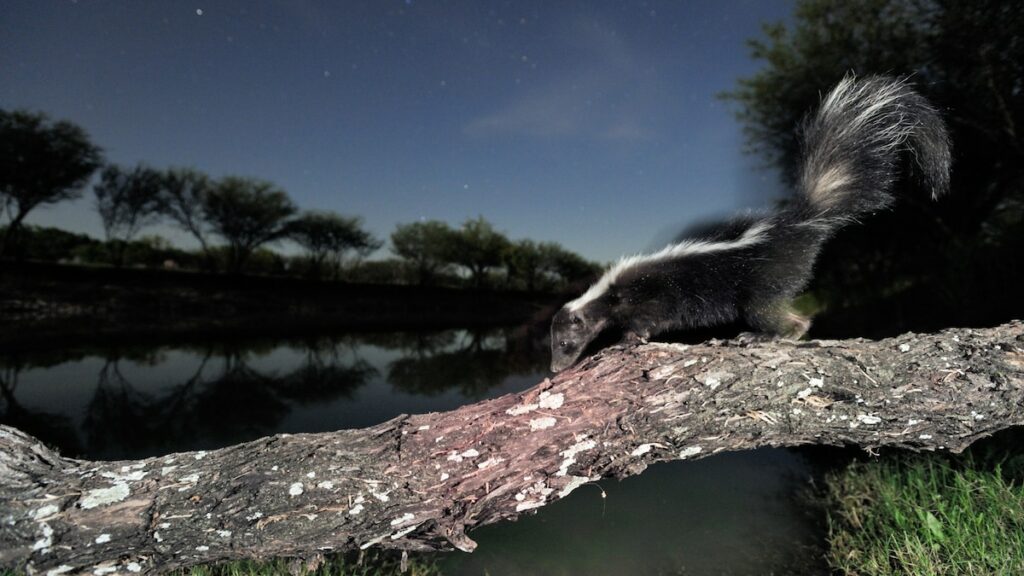If most people came upon a striped skunk, they would know to give the animal space or risk winding up with a face full of stink. After all, the idea that these North American mammals are noxious can be found in everything from field guides to Saturday morning cartoons.
But how do wild animals know that skunks pack such a potent punch? After all, even formidable predators such as bears, wolves, and mountain lions very rarely attack the black-and-white critters.
Believe it or not, though, scientists have never really studied whether the skunk’s black-and-white stripes are symbols of aposematism, or warning colors.
Most studies of predator-prey interactions and aposematism are done in poison dart frogs and toxic moths and butterflies, says Ted Stankowich, an evolutionary behavioral ecologist and director of the Mammal Lab at California State University, Long Beach.
But now, in the first study of its kind, Stankowich and his co-authors have made a new discovery: Most predators aren’t necessarily born fearing skunks, but rather learn by trial and error to avoid them. (Read more about why skunks have stripes.)
“These are things we assume,” says Stankowich, whose study was just published in the journal Animal Behavior. “We think we know, but we just don’t.”
Stinky business
For the experiment, scientists turned to a Utah population of coyotes that had either been born in captivity or removed from the wild before they left their natal dens.
Every effort is made to keep the animals wild in the 165-acre Predator Research Facility, which is run through a partnership between the USDA National Wildlife Research Center and Utah State University, says co-author Julie Young, an animal behaviorist in the Department of Wildlife Resources at Utah State University. “It’s a great place to do research.”
In the first phase of the experiment, the 49 study coyotes learned they could get free food if they approached a skunk-size model covered in brown fur.
The predators brave enough to eat food placed atop the models graduated to a second trial, in which the brown fur was replaced with black-and-white fur. But unlike the harmless brown models, the black-and-white ones concealed a small, remote-controlled nozzle that could spray skunk juice into the coyote’s faces. To ensure the coyotes’ welfare, the scientists used a spray solution that was just 0.9 percent skunk oil.
While all of this sounds like something out of Looney Tunes, the setup allowed the scientists to watch coyotes that had never encountered a skunk learn that black-and-white things are bad news.
Of the 36 coyotes that made it to this portion of the trial, 71.9 percent learned to avoid the skunk lookalikes altogether. What’s more, it only took an average of 2.4 sprays to learn the lesson—though Stankowich suspects that number might drop to one spray if they had used 100 percent authentic skunk juice.
Interestingly, the scientists also found that four coyotes wouldn’t approach the black-and-white models at all, even though they had no problem approaching and eating from the brown models. Stankowich says this is likely because the stark contrast between black and white is enough to scare them off. (Related: “Skunks can lose their stripes—and now we might know why.”)
In other words, both nurture and nature help coyotes learn to avoid striped skunks.
And while it was not tested specifically, the same combination of factors are likely at work for other skunk species, such as spotted and hooded skunks, says Stankowich.
“There’s both a predisposed wariness of this black-and-white signal and there’s a strong learning component.”
In a recent experiment, most captive coyotes (pictured, a wild animal in Florida) did not know to fear skunks on sight.
Photograph By Carlton Ward, National Geographic Image collection
Different personalities
In addition to investigating aposematism, the new study reinforces the idea that animal personalities vary across a population.
For instance, one particularly daring male coyote got sprayed nine times—the maximum amount possible, according to the experiment design.
In line with earlier research, the new study also confirmed that male coyotes were more likely to approach the novel objects than females. Similarly, young animals tended to catch on faster than older ones.
“So some animals are very, very bold and willing to go after stuff, even if they don’t know what it is,” says Stankowich. “And other animals are much more wary.”
Some coyotes that live in urban areas are bolder than their rural counterparts, and natural selection may lead to future generations of even more adventurous city dwellers. (Related: “Wild animals are adapting to city life in surprisingly savvy ways.”)
“That variation is really important to talk about and to understand what implications that has for wildlife and coyote-human conflict in our cities,” says Stankowich.
From skunks to spiders
“My initial reaction was that it was a very elegant way to demonstrate this concept,” says Andy Davis, a research scientist at the Odum School of Ecology at the University of Georgia who was not part of the skunk research.
Davis recently published a study on aposematism that revealed non-native jorō spiders colonizing the American South seem to recognize that monarch butterflies, which have strong orange-and-black warning colors are toxic.
Like the coyotes that avoided the black-and-white skunk models without interacting with them, jorō spiders only attacked a small percentage of monarchs in their webs, despite going after another orange butterfly at normal rates. Without touching or tasting the monarchs, the wild arachnids seemed to know the insects were unpalatable.
The results are tough to explain: It’s unlikely the spiders would have an innate avoidance of monarch patterns, since the two species did not evolve together, Davis says.
But this is how most studies on aposematism go, he admits: There are often various ways to interpret the data. However, he says the skunk and coyote study doesn’t suffer from that problem.
“I mean, there’s no ambiguity in the results,” says Davis.
>>> Read full article>>>
Copyright for syndicated content belongs to the linked Source : National Geographic – https://www.nationalgeographic.com/animals/article/skunks-stripes-warning-colors-predators
